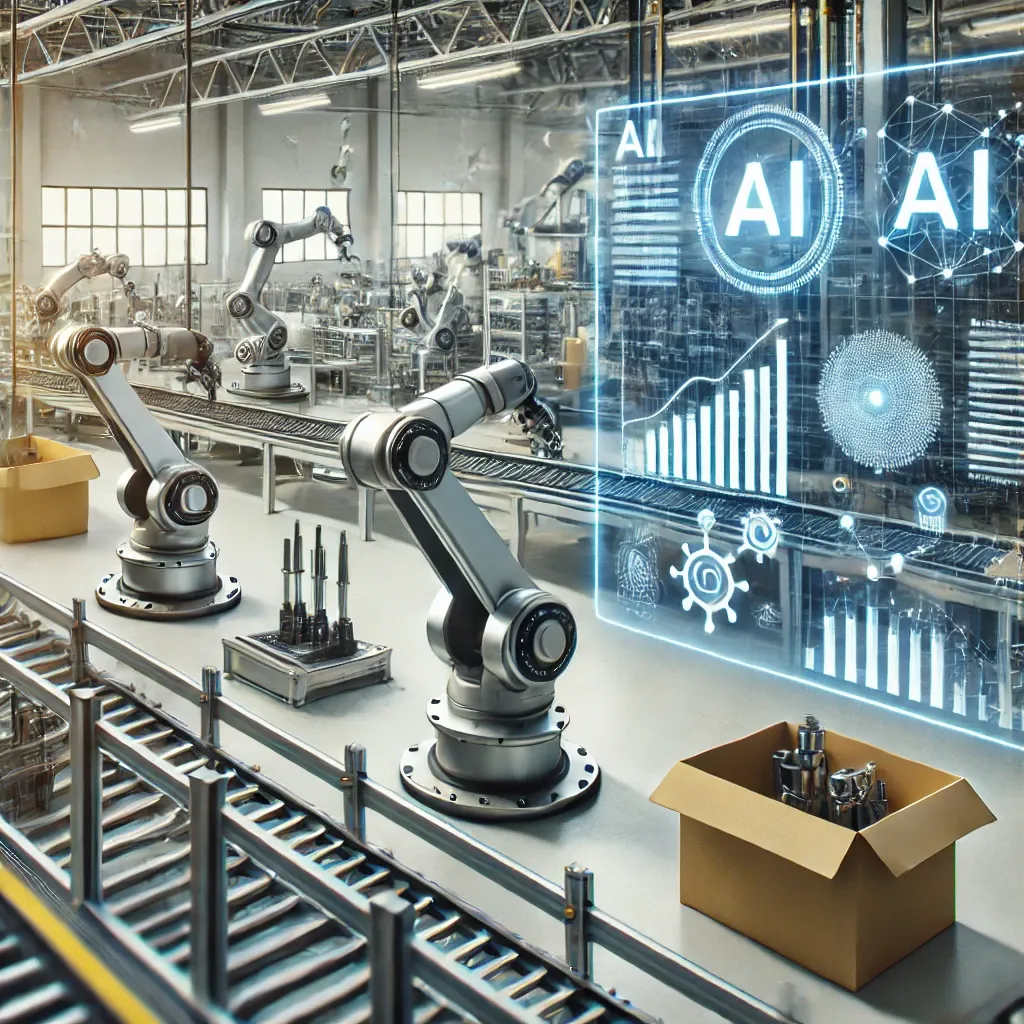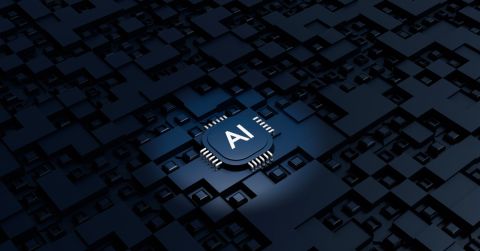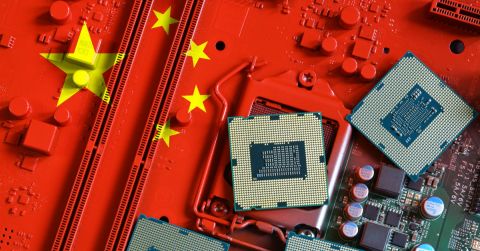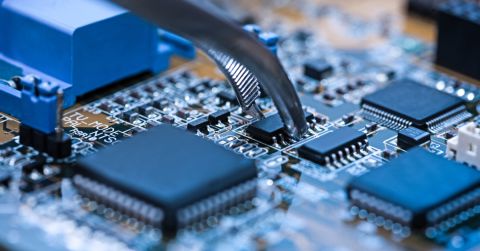Arch Systems: Changing Manufacturing with AI and Data Analytics

Welcome to the Ctrl+Listen Podcast, brought to you by Octopart! In this episode, we sit down with Andrew Scheuermann, CEO and co-founder of Arch Systems, a pioneering company in data analytics and process optimization. Andrew shares the inspiring journey of Arch Systems, a company on a mission to bring data-driven, actionable intelligence to factories around the world.
Discover how Arch Systems is helping some of the world's largest electronics manufacturers transform their operations through cutting-edge AI and machine learning. Andrew explains the importance of a unified data model in manufacturing, the role of AI in reducing waste, and the future of Industry 5.0.
Listen to the Episode:
Watch the Episode:
Key Moments:
- The evolution and impact of AI in manufacturing.
- How Arch Systems is driving efficiency and sustainability in production.
- The role of AI in reshoring and nearshoring manufacturing operations.
- The future of work in the era of AI and automation.
Links:
Connect with Andrew here
Learn more about Arch Systems here
Transcript:
James: Hi everyone, this is James from the "Ctrl+Listen Podcast" brought to you by Octopart. Today I have a special guest for you. It is Andrew Scheuermann. He is the CEO and co-founder of Arch Systems. A really fantastic company doing some exciting stuff in the space of data analytics and process optimization. Thanks for coming on the show. It's great to have you.
Andrew: It's great to be here, James. Thanks.
James: Well, anytime. For anyone who doesn't know the company, do you maybe wanna tell people a little bit about what your mission is, what the history of the company is, and how it got founded?
Andrew: Yeah, absolutely. So our mission is data-driven actionable intelligence for factories to enable a connected workforce and drive efficiency. We do this largely today for some of the world's largest electronics manufacturers like Flex, Jabil, Plexus, HARMAN, companies like that. But I would say in the long run, we're on a mission to help every discreet batch manufacturer worldwide foundationally transform their operations.
James: And just for anyone who isn't familiar, what does that term discreet batch manufacturer mean?
Andrew: Yeah, so it's focused on the fundamental way that you do production. So what's not included in that list is continuous production. So things that are common in like oil and gas or also some other industrial processes like power generation for example. And so we often say that to differentiate from like the whole wide world of industrial and especially in this conversation about AI and analytics like industrial AI, there are so many foundational amazing areas that you could help the world's industrial companies. And we're focused on a still very large set, which is all those that do discrete and batch. So discreet, you know, kind of job by job, and batch, like a batch at a time. That could be like pharmaceuticals. But another way to think about it is every manufacturer that makes something you could hold in your hand, right? Whether it's like phone, pair of glasses, a medicine. Company's about eight or nine years old at this point. Started the company with my co-founder, Tim Burke. Both did our PhDs at Stanford in engineering there. I built semiconductor equipment in the past, both in a research background and number of positions. And Arch's other co-founder, Tim, was in advanced analytics statistical methods. So in a way we kind of combined this deep knowledge of machines and how they're built. My own experience was more semiconductor and advanced analytics. And that's been true end-to-end for the company. It certainly was not a straight line path. Anybody who's listening who's ever started a company or joined an early stage company knows that it's a very messy, windy road and every story is unique. Our story, I mean, one of the really cool things that we cherish about our story, it's embedded in one our values. So we value empowerment, trust, and a job well done is this well done idea. So there's a nonprofit called Well Done International whose ongoing mission is to help supply water to the developing world, rural communities that don't have access to clean drinking water. My co-founder, Tim, was involved with a guy named Austin and a variety of others who were leading this nonprofit to give sustainable access to water. And they had pivoted from just trying to raise money for building new wells to actually using IOT devices, kind of data and analytics to monitor wells and see if they were still working. Kind of a version of predictive maintenance. If you think like back in the day, everybody would talked about how GE was no longer gonna sell jet engines. They were gonna sell like hours of uptime or amount of thrust or something like that that they would provide to an airplane. So in the same way, they were making this pivot from fundraise for a while to keep it up. And when we started Arch, our first thought was, "Wow, industrial AI." At the time, it was more industrial. Internet of things was the hot word to talk about it 'cause the emphasis was on the data part entirely as opposed to yet talking about all the things you would do with the data. And we were also trying to think what could we do that could transform the world? So we actually started with wells, with the nonprofit work in Tanzania and with for-profit work in California, such as on water wells for farms and mines. And so that was actually our very beginning, but we quickly kind of pivoted to what our backgrounds were most aligned with, which was electronics manufacturing, and then have been building from there.
James: Perfect. I mean it's one of those things where I think people don't look at the full scope of what AI and machine learning actually can and should be doing. I think there's like a sort of a predisposition. People think, "Oh, robotics and generative AI." But there's so much in between those two and you've just listed already in the show so many ways that AI can be beneficial to businesses.
Andrew: Yeah, absolutely. Yeah, I mean, robotics and AI are, and generative AI are kind of motifs in a way. The same thing like data or internet of things is, right? And they're, personally, I'm by far the most excited about these vertical applications of AI. Like the models themselves are super interesting, but they're interesting kind of because of what you can do with them, right?
Andrew: Like you can transform-
James: Right.
Andrew: manufacturing, you can transform engineering, operations, maybe product design, right? Among so many other things.
James: Yeah, and areas people don't even think of. We had someone on the podcast recently is using this type of stuff for aquaculture to optimally breed shrimp. So yeah, it can be used literally anywhere.
Andrew: Absolutely.
James: So how can a unified data model help companies to operate more efficiently exactly? So how it work on the nitty gritty side of things.
Andrew: Hmm. So yeah, there's been a number of ways people have been talking about. I guess you used the word or the term unified data model. Standardization is another one people have been saying. Sometimes even digital twin. People talk about like, but again, that kind of standardization of your digital twin. So one of the underlying problems in all of the industrial spaces with actually applying analytics and AI is having access to standardized, normalized data instead of the opposite of that data first that's siloed in all kinds of different applications and different machines in the factory context. And then even when you get it out, it's named entirely differently. There's a lot of like, I would say boring, but really important things like this machine calls temperature differently than this machine calls temperature. And so you can't compare temperature to temperature unless they both say temp_x or whatever the naming needs to be, right?
James: Right.
Andrew: And then there's more like profound implications of a unified data naming scheme. Like if you are building a product, something like a medical device or an iPhone and you want to think about all of the components of that device and the different qualities, the different ways they could have had defects that build up into that end device that's either working or not working in somebody's hand or heart, then you need to have this kind of unified data model at every step of the way it was being built if you're gonna analyze that in one shot. Now, that's not the way the world works today today. Today, data analytics is still, data analytics and AI are honestly still in very early days from my perspective. Analytics is happening often only on even a single machine, not even just like a whole production line. Definitely not a whole factory to a whole supply chain to an end product, right? And so that's one of the big things that this unified data model is absolutely essential for is not just having some really cool, for example, predictive maintenance on one machine. Maybe a robot is picking and placing something and we can predict if it's gonna drop the part or break. Okay, that's really cool, but what about the whole context of the line? Can we predict if the whole circuit board is gonna be made high quality or if we're gonna meet our goal by the end of the day, how about the whole medical device, right? Can we predict and monitor that it's actually made correctly that the tolerance didn't add up and that we can be highly confident this thing's gonna, you know, if it's a pacemaker, for example, live in somebody's heart for decades to come?
James: Right, right. So do you think, having said that, I mean data silos, the way we've traditionally viewed them, have just been something that can operate outside of everything else. It just exists as a silo. Is that changing? Are people have seen that there's not as much value in just having these vast stores of data and they analyzing them and actually extracting that data is where the real value is?
Andrew: Definitely. I think, I mean, first there has to be some level of appreciation for software and digitization to create the silos, you know, 'cause there was a point where there wasn't enough data, but that was years ago now. You don't talk to anyone in manufacturing and they tell you, "I don't have enough data." Like everyone says that. So much data dying in it, right?
James: Yeah.
Andrew: But it did have to start with that. It had to start with having lines with what are called PLCs program, a logic controller is running them, and then smarter pieces of equipment. You know, a whole pick and place robot, amazing inspection equipment, taking all kinds of pictures, having a SCADA or a manufacturing execution system. It had to start with that, kind of buying these different systems, which were great, to then recognize now I have all these silos of data or these islands of automation and they don't know how to work together. And I'm increasingly dependent on people to have a very specific skillset of knowing how in their heads, to log into all these different engine systems and understand an increasingly complex web of data. And that's not actually something that humans were like meant to do. It's like log into 30 different software programs and kind of like figure things out in their head. That's a computer thing. We've created kind of a computer problem, right? So analytics is a perfect, you know, data desiloing, right? A unified data model analytics is a perfect solution to that. But where AI really comes in is AI translates data into the language of humans. And that's what's foundationally exciting, you know, far more than just analytics because now we get to work with computers in a very human way, and that's elevating all the use cases that you can do to a whole new level.
James: So basically, I mean it's practically making this data consumable for humans as opposed to before, there's just this fast network of data that was like, "Okay, something's in there that's useful, but we have no idea how to get to it or where it is."
Andrew: Yeah, exactly. And like anyone that's ever tried to home build their own team to make their own like data analytics stack and a manufacturer, anyone that's built a company, realizes how many sub-disciplines it takes to do a single dashboard even, right? Like you need someone to talk the native protocols of whatever that machine or system is. You need different types of data engineering, you know, depending on like the speed and the size of the data. You might need not just one database, but multiple different ones, then you start getting into being able to build your front end user application or dashboard, whatever it is. And so it's not even just like one great engineer or data science person. Like you need a team of like eight to 10 sub skillsets, which are very specific to stand up, even a basic system, right?
James: I think that's good to know. I think people don't actually understand the scale of it. So thank you for explaining that. So this kind of a second part to the previous question when we were talking about data analytics in manufacturing, do you think it's come to a point now where if people aren't employing this in their business, they're falling behind?
Andrew: Yeah, without a doubt. I think that the best manufacturers are extensively using analytics throughout their enterprise. There's no question that they have lots of pieces of equipment and robots that have sophisticated analytics built inside of them, but they're also de-siloing that and doing analytics across their plants. Not just single plants, but multiple plants. And they're starting to build sophisticated AI agents to do multiple tasks. I think 20 years from now, I guess to put it bluntly, I think 20 years from now, maybe even less, but 20 years from now, a manufacturer that's not using any AI is probably a manufacturer that doesn't exist.
James: Yeah, that makes sense. So the next question I was going to ask, you've kind of covered a little bit already, so maybe we'll just touch on it briefly, which is, how have you seen the role of AI change in recent years in the manufacturing space specifically?
Andrew: Yeah, so first, when people talk about AI, it's funny now people talk about, do you mean the old AI or the new AI, right?
James: Yeah.
Andrew: Because there's this generative AI, the kind of language foundation models or the talking AIs that are so exciting. And then there's the AIs we talked about before, which are, they're both, at the end of the day, predictive models. But we now more commonly like to call the old AIs machine learning, which means that you had tons of numbers and symbols and you created a model that made predictions. Well, the new talking AIs like OpenAI, ChatGPT, they're also predictive models, but they're predicting words and then generating the next set of tokens, right? A next set of characters for words. But they're so powerful and so general that everybody can use them. We don't use, like in our manufacturing product, we don't use open AI model to like predict which word comes next, right? We don't say like, hey, you're trying to tell someone how they should fix a defect. You should first open, tell me what the next word is. Like we don't do that. We can jump to a whole higher plane now. And I think that's what's so exciting about the new AI combined with the old AI. And maybe we're gonna get into specifics here in a moment, but at a really high level, the old AI, which is machine learning prediction on individual numbers, sensor values, that sort of thing, is extremely powerful to predict when something's gonna happen. Like is a machine gonna break? Is the temperature gonna get too high? Are you running at a fast enough rate that you're gonna complete your order on time? And those are now the questions that can be asked to the new AI, the generative AI to tell you what to do about it. So everyone's been talking about this cycle going from descriptive diagnostic, predictive prescriptive in industry. And what that meant was, okay, your basic dashboard, which still took those eight engineers to build, if you were building it from scratch, just to be descriptive, said, "Hey, I have a KPI. My machine is running or my machine's not running, or I make a part every 30 seconds." And then the diagnostic said like, you know, why is that the case? Is there a reason that your machine is down? So for example, a really common early analytic system was just, are my machines running? Yes or no? A single sensor value can tell you that. And then the diagnostic one, if your machine was down, somebody would click a button and say, "It's down because I'm out of materials or it's down because there's nobody here to work anymore." Was there anyone even to click the button for that? I don't know. But you know, you have a reason that it was down, that was diagnostic. Predictive was the old AI. Can you use machine learning to predict it's going to go down before it actually does? And now the predictions can be, are the questions into the new AI that says, what do I do about it, right? Because I had those diagnoses in the past, I'm using downtimes as an example here, and I knew when this sensor went off, it tended to be the case that the line was down because we were out of materials or it tend to be the case that the robot was broken. I'm now predicting I'm going to be down and I think it's because I'm running out of materials. What should I do about it? The new generative AI can give you a playbook and say, "Here's exactly how you go get new materials and load them into machine," or, "Here's how you fix that part on the machine." And that, again, is it's kind of, it's funny because in the industrial space, everybody's been saying for 10, 15 years, like that's what the technology needs to accomplish. Everyone's known that that's what it needs to do, but it wasn't possible until recently with these new generative ai. And so it's kind of interesting to almost look back at history and like, it's like we were all hoping there was going to be a technology like this without knowing for sure. And now that it exists, we can kind of complete the picture of what analytics was supposed to be doing.
James: So we've seen people describe the new wave of AI revolution as Industry 5.0. Do you see this as like a revolutionary age that's occurring right now in manufacturing industry?
Andrew: So yes, and so I'm personally not a huge fan of the I5.0, but it's funny. You know, I think the reason people say it is back to what I said before, everybody's been saying, in the past, it was like what is 4.0 supposed to be? It's supposed to be we go all the way from having data. Like what was 3.0? Like 3.0 was the beginning of having computers in manufacturing for example. So like one was a steam engine, two is like electricity and mass production, three is computers, four is used data. And everyone has been saying, how do you use data? You go all the way to prescriptive guidance. Like you have a system that knows what's wrong, predicts it, and tells me how to fix it. But what, until generative AI, nobody had a technology that could go all the way. And so the best you could possibly do was a really cool advanced analytics dashboard that sometimes got it right to predict a problem, right? So I think that's why people are calling it 5.0 versus 4.0. But again, I say that because like, this is, I think this is important for people to understand. It is both what we've all been waiting for and it is totally transformational at the same time. Like everybody's been saying, "We need this." We need this for a decade. And the fact that it actually exists should still surprise everyone and make us say, "Wow, something like expected and unexpected happened and the impacts of this are truly massive in terms of how much economic opportunity can be created in terms of how much the future of work is gonna be different because of this technology."
James: Well, that's, you raised a good point there, which is a question I was gonna ask at the end, but I'll ask it now. There's a lot of people who do fear AI taking their jobs obviously. I imagine you'd have a different perspective on it as many people do say it's more of a tool to make your job easier and more efficient than it is to replace you. So what are your thoughts on that whole argument?
Andrew: So every industrial revolution has changed the nature of work a lot, right? Like in the first one, if your primary job was to like, you know, lift a bucket, it was like, oh, there's a steam engine that can turn a wheel and you don't have to do that. But nobody cries about that anymore. We're really glad, right? Same with the second, there was a conveyor belt, there was electricity, people used to flip switches in the factory that was like created the relay switches that could start doing early logic. And in the third one, you used to have to create all kinds of manual programs and rejigger your factory. Now you have reprogrammable equipment. So every industrial revolution has fundamentally changed the nature of work. And there are certain jobs that are no longer necessary, but people who understand what they're doing and are gaining new skills always prosper more. Now I did kind of leave a room there. Some, there always can be people that are displaced or hurt when new technology comes in really quickly. And I think that's important to acknowledge because it's not all rainbows and sunshine that like clearly everyone will be better off. There'll be no disruption. There is disruption and there are people who say have spent 10, 20 years learning one skill and turns out they're unlucky. That's the skill that has gone away versus is even more important. And we need to help those people. Someone even threw out an acronym to me at one point called renew, like renegotiated worker training or these ideas of these programs that if you recognize, some people are suddenly more important, good for them. You know, you recognize someone's job is suddenly obsolete, let's go out of our way to help them and retrain them. And I think the best manufacturers are thinking about that. And that becomes a key differentiation because even if you happen to be the worker whose job is suddenly better because of this AI, you still feel better, still feel better when you see that you're part of a culture that values all of its people and brings them along versus you see the person next to you thrown under the bus. So I guess that's the nuanced answer I'd give. I'll end it with a piece of optimism because I'm definitely exceptionally optimistic about AI and what it does. And for the most part, we're, the things that we're automating are like the dirty, dull, and dangerous or disappearing is another D. So like dirty, dull, dangerous jobs, like things we don't wanna be doing, things that are hard. And the other one is the disappearing. So this is a big thing in manufacturing, which is that in the past, people spent 20, 30 years doing the same job in a factory and they got exceptionally good at it. And AI can change the nature of that, but the order is the other way around. Humans have already decided that most people want to change the job they're doing far more often than 30 years. And so a massive problem in manufacturing right now is they have a 10 million skills gap because there aren't people who are just like, I'm so excited to run this one type of CNC machine for 20, 30 years. And so they can't hire somebody to do that and the machines are hard to run. And so this idea of an AI copilot that can allow somebody with just one, two, three years of experience to act way more capable in their job is exactly actually what we need in manufacturing to solve a problem that already exists.
James: Great answer. I'm gonna come back to that a little later on because there's another question I wanna ask regarding that. But first, I think we should probably talk a little bit more about your product. The ArchPro, I think it's GLO is the one we discussed earlier.
Andrew: Yeah, GLO or GLO. So it stands for global and local operations intelligence. Kinda of a funny phrase. It would be like want every factory to be able to glow like a lighthouse, right? Like in the past, manufacturers had one great factory that was the lighthouse and don't pay as much attention to the other 20 factories that are further behind. And so one of the points of our product is how scalable, how easily deployed it is, how easily maintainable it is and that we can spread data, best practices in AI across many factories.
James: What's sort of the turnaround time for, I guess getting established with your system? So say like someone decides to, they wanna opt in, how long would it take from that point to it being operating?
Andrew: So if we break down, in the past, you first had to overcome the data silos problem we talked about in the beginning. You had to connect to maybe all these machines, different systems. You had to pull that data out. We talked about a unified data model. You were creating that from scratch as well if you were building your own, then you were standing up different dashboards. Now you were gonna build your own predictive algorithms and then there didn't even exist generative AI to try to bring that into the mix too. But if you were still trying to build your own system today, now you're learning how to do generative ai. So some of the projects in the past have been years long, you know, five years long, and they've gotten to just one, two, three factories, which is why that lighthouse term that I said before, you know, could all your factories glow like a lighthouse? It's like that didn't happen in the past. There was one, two, three totally amazing lead plants. They were the examples for everyone else, but you would generally find the other factories had, this had just not gotten there. With Arch, we were able to deploy tens of factories in just months. A recent one that we did, we went to about 26, 27 factories in a customer in about four months time, connecting to 2,000 machines. So that's the first piece that we've done. It comes from our background in IOT before AI that we can connect to any machine, any protocol, new and legacy over 10 times faster speed than ever before. And sometimes it's even like 100x speed up. The reasons are we're, you know, in the past, you have this, everybody doing it on your own, the system integrations model. And you would start from scratch. Like we are going out and writing every protocol, every adapter that exists. And once we've written it, we're done. We can reuse it at the next customer. And we don't charge them for that. That's one of the reasons we can do it because in the past, that's how people made money was writing those integrations. We don't make money doing that. We make money by selling the analytics and the AI that directly improves the factory's efficiency. So it's also a loss for us to spend a bunch of time on connectivity. Consequently, both because of the economic reason and because we've leveraged some amazing technology and brilliant people, we've sped up the deployment cycle just incredibly. So anyways, 10 to 100x speed up, tens of factories every month.
James: Wow.
Andrew: And that's really exciting for our customers as you can imagine because now you can do cutting edge thing in your lead plants, but you can also bring 10, 20, 30, 40% KPI improvements to the other plants that in the past, didn't get technology as quickly.
James: That's awesome. Really quick turnaround. Wow. So there's two words that people always like to focus on, which is waste reduction. How does automation in this sense actually reduce waste? And I don't mean waste necessarily as time specifically, but also waste as in wasted revenue or wasted product. Any type of waste.
Andrew: Okay, it's a good clarification 'cause there's tons of wasted time that's taken out because of data automation, but yeah, wasted product, wasted materials, you know, scrap for example in the factory or making B grade materials. In a really fundamental way, I guess I'll give, you know, early on we've talked about how your analytics or your AI can just be very simple. It can just tell you what's happening or it can tell you why or it can predict it or it can predict it and tell you how to fix it predictably, right? So maybe I'll tell this in the example of some use cases. Let's start with a simpler use case in electronics, which is you have pick and place machines picking up chips and putting them on those green circuit boards. And one of the ways that you can get waste in that type of factory is that the robot picks up the chip wrong and it can't put it on. And so it has to throw away the chip. That's called attrition. And so you get these perfectly, otherwise perfectly good chips that just get thrown in the trash bin. And sometimes there're these resistors that cost a fraction of a penny. Still generating physical trash, but it's not too much money wise. But other times, it can be expensive chips. 10, 20 cents, even couple dollars a chip, right? So if you have good analytics that's seeing that happen in real time, maybe it's integrated into your other enterprise system that has the costs. So you can see both in like amount of material that's being thrown away, cost of material that's being thrown away. Maybe you can see how much material's being thrown away relative to how much you still have. You especially think about COVID when everyone's running out of materials. Still happens today. The analytics can paint that bigger picture for you of like do you care, how much, you always care, but like how much do you care about this particular waste? Because the reality in the factory is there's waste, there's materials being thrown away, there's defects, there's repairs happening all the time. And what analytics does is it sharpens your focus and it tells you online three right now, you are wasting at 20x the rate of any other line and you just need to go and fix this one spool of materials, right? Or you need to go and make a repair on that one robot head and you're gonna be able to save a hundred thousand dollars worth a year of waste happening. And so that quickly brings you to eliminating waste. Really quickly, I'll make a really advanced example, which is, let's imagine a medical factory. And a lot of times, if your products get all the way to the end of the line and then the quality isn't good, go back to the pacemaker example, you just throw them away. You don't try to repair them because it's too important that these things work perfectly in the field in somebody's body right? To take any chances and regulations are there to back that up as well, right? So even though it would be more cost effective to repair it, you can't do it for safety. That means it's exceptionally important to have advanced analytics that could predict any of these problems that might be building up so that you can actually solve them at the front of the production line instead of wait all the way to the end and throw away an entire device, an entire pacemaker instead of just throwing away one chip, one component that couldn't be saved. So two different ways and it's, yeah, this isn't a small deal. It's a really big deal of saving materials and waste in the factory and it's a, one of the top ways that analytics does drive value.
James: I think especially now with all the new regulations in Europe. And I'm sure there'll be something in the US to follow regarding like waste disposal efficiency, yeah, recyclable, well, how recycled all your products are, how efficient your actual process is. These are all things that companies are gonna be struggling with more and more going forward. So I think this will really help with that space.
Andrew: Yeah, exactly. That's a good area for kind of public private partnership and government to come in. A lot of times, there can be areas of overregulation, but if government identifies those areas that are about safety, like in medical or about recyclability on particularly important materials or things that are more harmful for the environment when thrown away, they can potentially make good regulations and then technology can help answer how do we deal with that? How do we decrease the waste on something that we just, you know, is even more expensive if it has to go into the landfill, right?
James: Right. And speaking overseas markets, there was a really important topic I wanted to discuss with you, which was nearshoring and reshoring. Obviously, there's a big argument that it's cheaper to manufacture overseas because wages are lower. Is AI and this sort of automation the way to get around that to reduce cost of manufacturing in places like Europe and the US?
Andrew: Interesting question. Yeah, a big one that people are thinking about. Okay, I'll have to unpack this one a bit 'cause there's a simple answer that just says yes, definitely it has the effect that you said, James. If we were just talking about government regulation, so let's assume government regulation just stays flat and let's also assume that everyone adopts AI flat. No one is like way further ahead in AI than others, right? Okay, now the big change is just how much AI technology versus how much labor are you using? And the reason that there was so much outsourcing like you said was lower labor rates. And there was tons of labor needed in the factory. So yeah, now you've replaced a couple hours of human labor for a couple data transactions and a server costs the same anywhere in the world, or it can cost anywhere the same in the world and the human labor doesn't. So that absolutely is like a one-way arrow back towards countries that have more expensive labor rates, right? Is they're, again, favored. Right, I think the key thing to think about though is like what did we rule out when we said that we assumed that countries did the same thing in terms of regulation and favoring their own industry, and we assumed that everybody adopted AI the same. Because if certain countries are far ahead in AI and adopting it really well, they could have the lowest labor rates and the best use of AI and they could be further ahead than they are today. So it's really important to think about this. And this is something I get frustrated about sometimes myself. We're an international company and we work with everyone and we wanna help the whole world rise. And so I don't want to weigh in too much on geopolitics here, but like we're a a US-based AI company. The best factory that we have in our network right now in the world that's using the AI the best is in China.
James: Interesting. Okay. I mean do you kind of see, I guess the nearshoring, reshoring trend as a bit of a knee jerk reaction to what happened with supply chain issues during COVID?
Andrew: I think that, I think it's exceptionally important for everyone to adopt AI together. And if different people are in different countries and they should want their own country to be ahead or at least on par, right? So I'm an American, I certainly want the US to be on par or hopefully ahead, right? But at the same time, we want the whole world should be doing AI together and cooperating on that. I think that a lot of the reshoring and nearshoring came from realizing that geopolitics has fundamentally shifted. That the US used to kind of police the whole world with our Navy and just maintain a certain level of globalization and we're pulling back from that. And the US kind of wants a little bit more of an isolationist stance. And that has caused both the US and all countries around the world to kind of decide, you know, we need at least some production close to us, like in our own country. And that is a very real thing that's driving very significant both reshoring and nearshoring. Technology has the potential to accelerate this in a positive way. If you're in India, you know, you both have a country with a huge growing population, so you can bring in manufacturing because of low cost labor. Also, they're investing in advanced technology. They could bring it because of advanced technology, right? If you're in the United States, you know, we've got a nearby neighbor, Mexico, fantastic country, lots of brilliant people, and a lower labor cost than the US. So we can be nearshoring in Mexico, we can be reshoring in the US if we're ahead on technology. And I think that the last, the current administration, I guess, in the US passed the CHIPS Act to really heavily back semiconductor production in the US and that's had a big result in kind of one area of manufacturing. But if you think about all areas of manufacturing, the critical parameter is adoption of AI. Like that is the critical parameter that will, and in over the next say 10, 20, 30 years, affect how much reshoring versus nearshoring happens from a US perspective.
James: Right. I was following the trend with that and there was a, I think it was 2030 that were estimating. There was gonna be a massive, I guess, deficit of skilled laborers in the US to actually meet the number of jobs they expect to be creating. So I think AI is gonna, like you said, definitely be crucial in meeting that demand.
Andrew: Yeah, you know, the estimates that I've heard, I may have mentioned them earlier, were like around 10 million worldwide and a million in the US. That's 10% of the worldwide unskilled labor gap in the US. And in lots of areas of manufacturing, we've fallen at 10 or below 10%, right? So that particular issue is definitely very acute in the US. And certainly, some US manufacturers feel this urgency very directly and are starting to invest heavily. Europe's been investing heavily. You know, Industry 4.0, that's a term that was coined in Europe, in Germany, I think. Industry like and they've been investing heavily. China's investing heavily too, you know, built in China. And again, this is a good thing that like the whole world recognizes the ability of these technologies and overall we have collaboration. And I think it's healthy. I'm a huge, you know, we work again with all countries and we have friends and we have employees absolutely everywhere. And so I'm a big fan of manufacturing in Asia, manufacturing in China. They're exceptional at it. And at the same time, I think it's healthy for the whole world to have this redistribution and kind of getting back to a more balanced state. And I guess if I can throw in another exciting AI thing that we didn't talk about yet. One of the amazing things about these language talking AIs is they talk in all languages. And so one of the things that was hard before was say you had a global manufacturer, you had a plant in China, in the US, in Mexico, in Germany, et cetera, and you got everybody in one room and said, "Share your ideas." They speak different languages, right? And so they would probably end up using English on average, that's the more common business language, and it wouldn't be a very equal exchange of ideas, right? With AI, we have these systems now where people, in their own plants, in their own countries, can describe and give more information about how they're solving specific problems. And we can directly train models and put that information together in their native language and have it kind of properly weighted and understood into these agents that can guide people back in the other places. So you can figure out something in China and then use that knowledge in Mexico. You can figure out something in the US and use that knowledge in Germany, et cetera. That's actually really exciting for international collaboration. In summary, that's what I would say. I think it's healthy that there's this rebalancing in the world and we do have to think about some of the confrontational aspects of geopolitics, but overall, I think the collaborative aspect of it, like we have another chance to be collaborative in a new better way in this kind of next phase of globalization.
James: Right, fantastic answer. I could talk about that all day, but, so we've kind of, we've come up on time, so I just wanted to ask you one last question, which is there anything coming from your company that people should keep an eye out for anything exciting in the works?
Andrew: Absolutely. So what if people have been following us or if you haven't been, check out our website, and our social media feeds and everything. If you've been following us, you've seen our evolution of just connecting individual machines to sets of machines. You've seen us focus in on surface-mount technology and electronics. You've seen us start expanding from the SMT to the backend, the whole PCBA factory to injection, molding, CNC, semi packaging. And so we've been kind of increasingly expanding the scope of machines and protocols that we already talked and already understand into analytics. I think the most exciting thing, not just that continued expansion to more types of factories, is the use of generative AI to capture tacit knowledge in the factory. So tacit knowledge referring, again, back to these, the experts, the people that are retiring, as well as the documents and things that aren't put together today because they're not like sensor values or numbers, they're kind of words or thoughts or ideas. Now we're able to start gathering those things. And we gave the example of kind of the multiple languages coming together, but just one very concrete example that we have in kind of alpha form right now with some of our customers is we talked about how all manufacturers have a very practical problem of downtimes on their lines and they need to understand why the downtime occurred. They need to root cause it. And almost every system in the world today works like manual root causing. Someone comes in and writes a report or clicks a button to say why it happened. And we have an application now that uses generative ai. It can understand which machine, which root cause cause this automatically and label these things as well as provide some guidance to help people improve the factory. So that particular use case is one that I think people should look out for in kind of the very near term. And then in the longer scope, just what do you keep discovering as you combine greater sets of data with these generative AIs and how is that interaction between worker and AI evolving is the most exciting area to follow.
James: It's fascinating. It's stuff people don't even think about, but it's gonna change the way the whole world operates over time. Andrew, thank you so much for coming on the show. It's been absolutely fascinating talking to you. And anyone listening, follow what Andrew said. Go check out their website, go check out their socials, stay up to date 'cause exciting stuff is coming.
Andrew: Thank you, James.
James: No problem. And anyone listening, come back next week. We will have another guest.









 Back
Back